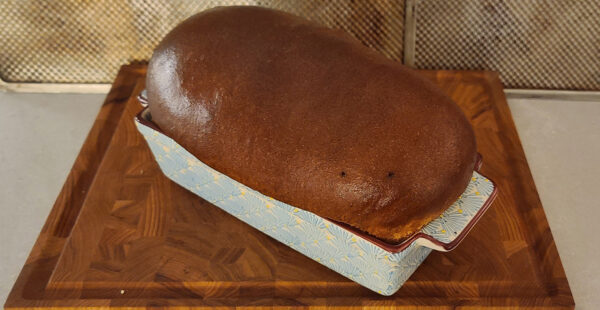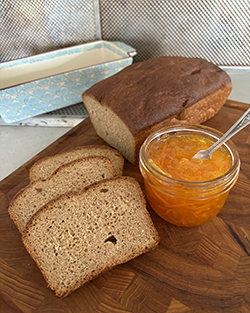Reminiscing about History … and Bread

The Northwest Kidney Centers Dialysis Museum has relocated to SeaTac after 45 years at its original site. I was invited to attend the grand opening in March, which caused me to reflect on visits to the original museum and my work at Northwest Kidney Centers. And it was fun to see exhibits once again—the original dialysis machine (made from an old washing machine), the traveling “suitcase kidney” that literally used an overnight case to hold a dialysis machine for traveling, the huge glass bottles used to hold dialysate (staff always coveted the bottles for use as a terrarium) and, of course, photos and mementos of the many patients who have passed through the doors of the centers.
One of the best things about working in health care is the amazing people you get to meet; people you may never have met otherwise. In my 42-year career at Northwest Kidney Centers, I met thousands of amazing people dealing with difficult health issues in heroic ways—a bank teller, a veterinarian, a professional football player, the father of an Olympic athlete, a millionaire, a homeless man, a doctor, a nun, a Cambodian refugee, a poet, a chef, a jazz singer, a comedian, a Japanese American interned during World War II, a nurse, a student, a librarian who used me as her nutrition expert, an engineer, a journalist, a food stylist who taught me great tricks, a waitress, a theologian who lent me a book he wrote, a veteran, an Eagle Scout living on a sailboat, a social worker, a painter, a weight lifter, a quilter, a teenager, a 9-year-old, a 94-year-old … all with stories.
 One of my patients was the first coach and later manager for the Seattle Sounders soccer team, John Best. Never one to let barriers stand in his way, he not only followed the difficult dialysis diet and went on to have three kidney transplants, he also started a company to deliver meals to patients with complex nutritional needs. This was 20 years ago, before such programs existed.
One of my patients was the first coach and later manager for the Seattle Sounders soccer team, John Best. Never one to let barriers stand in his way, he not only followed the difficult dialysis diet and went on to have three kidney transplants, he also started a company to deliver meals to patients with complex nutritional needs. This was 20 years ago, before such programs existed.
The soccer coach recruited a friend to serve as chef. Together they developed a wonderful recipe for high-protein bread, which they delivered with their meals. Thankfully, Chef Rick Milton, gave us the recipe for the bread. You can find it below and also on the Northwest Kidney Centers website, along with other wonderful recipes.
Bread is one of the six hidden highest sources of salt in the American diet, but John and Rick’s recipe is very low in sodium, with only about five percent that of regular bread, and it’s high in protein. Regular bakers may question the lack of salt in this recipe as it is normally a “must add” ingredient in bread to control the yeast rise; however, with both whole wheat and gluten flour, this bread has great texture without salt.
If you feel your bread needs more flavor, add a grating of lemon peel or add fresh or dried rosemary or other herbs to the dough before baking. You can also top your slice of healthy homemade goodness with flavorful low-salt toppings such as jam or flavored cream cheese.
If you would like a wonderful historic homemade loaf of bread that is healthier than anything you can buy, try Rick and John’s recipe. It makes two standard size loaves. You can bake two and freeze one of them. If that sounds like too much, you can always cut the recipe in half as it also works well as a single loaf.
Look for wheat gluten in the specialty baking ingredients section of your grocery store. Bob’s Red Mill brand is one option. You can also order it online.
High Protein Low-Salt Bread
3 cups whole wheat flour
1 cup all-purpose flour
1/2 cup wheat gluten
2 tablespoons sugar
2 tablespoons yeast
1/3 cup honey
2 teaspoons canola or vegetable oil
2 cups warm water, 95–105 degrees
1 tablespoon butter, optional
- Mix flours, gluten, and sugar in a mixing bowl.
- In a separate bowl, mix yeast, honey, and oil into the water.
- Let stand and stir a bit until the yeast is dissolved, about 5 minutes.
- Mix the yeast mixture into the flour mix to create the dough.
- Knead the dough until you have elastic consistency, adding more flour to the board as needed. Usually this takes about 5 minutes.
- Place the dough in a clean, lightly oiled bowl and cover with a towel. Leave it alone until it doubles in size. Dependent upon heat and humidity, this will take 45 minutes to an hour.
- Pre-heat oven to 350 degrees.
- This recipe makes two loaves of bread in two standard loaf pans, or one large loaf in a longer 5×9 bread pan. You can bake two loaves and freeze one, or you can cut the recipe in half and make a single loaf. Whichever you decide, spray or grease your pans with oil.
- Punch down dough and place in your pans.
- Let it rise again just to the top of the pans. This could take anywhere from 30 minutes to an hour.
- Place in oven for 50–55 minutes (start checking for doneness at 45 minutes if you are making two separate loaves). The bread should have a rich brown color and should have a hollow sound when you tap it. Internal temperature should be around 200 degrees.
- Rub the top of the loaf with the butter to make a softer crust. If you like a harder crust, you can omit this step. Remove loaf from the pan after it is slightly cooled. Let the loaf cool on a rack before slicing.
Nutrition information per slice (about 16 slices per loaf): Calories: 164, Carbohydrates: 31 gm, Protein: 9 gm, Sodium; 5 mg
Note: If you would like to schedule a reservation-only visit to one of the world’s most unique museums, call Northwest Kidney Centers at 206-292-2771. The reception staff will be happy to schedule a time for you to visit.
 Contributor Katy Wilkens recently retired as registered dietitian and department head at Northwest Kidney Centers. The National Kidney Foundation Council on Renal Nutrition has honored her with its highest awards for excellence in education and for significant contributions in renal nutrition. She has also been awarded the Medal of Excellence in kidney nutrition from the American Association of Kidney Patients.
Contributor Katy Wilkens recently retired as registered dietitian and department head at Northwest Kidney Centers. The National Kidney Foundation Council on Renal Nutrition has honored her with its highest awards for excellence in education and for significant contributions in renal nutrition. She has also been awarded the Medal of Excellence in kidney nutrition from the American Association of Kidney Patients.
Photos by Rich Wilkens.
Eating Well, Living Well classes
Studies show that working with a registered dietitian can delay kidney failure and postpone dialysis for longer than two years. FREE nutrition classes taught by Katy’s former team of registered dietitians are available at convenient times and locations around Puget Sound. Eating Well, Living Well classes teach people how to eat healthier to slow the progress of kidney disease and postpone dialysis. Learn more at www.nwkidney.org/classes.
![AgeWise King County [logo]](https://www.agewisekingcounty.org/wp-content/themes/agewisekingcounty/images/logo.png)